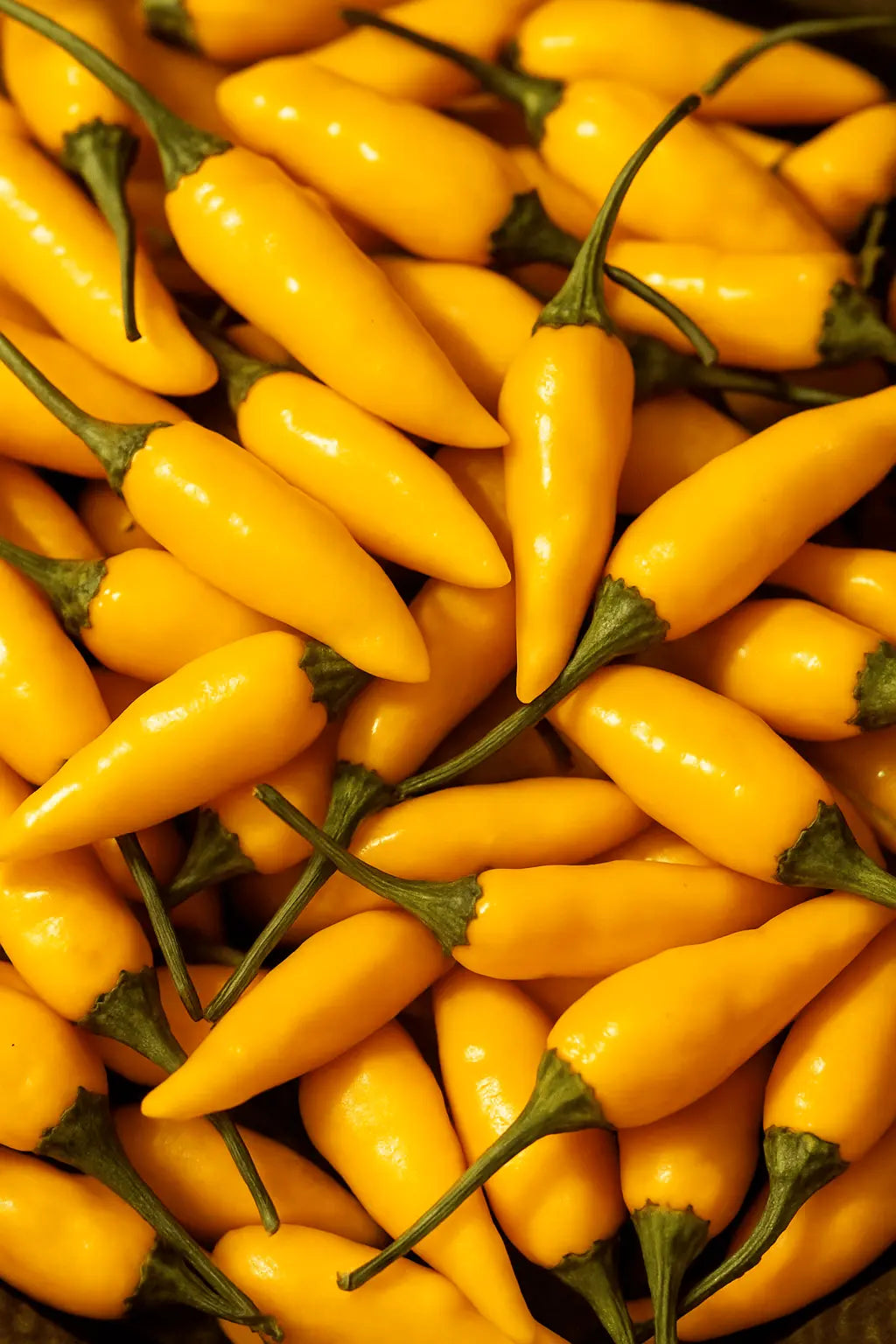Aji Lemon: The Complete Guide to the Lemon Pepper That Electrifies Your Kitchen
The Aji Lemon, also called Lemon Drop or Ají Limón (Aji means pepper), is intriguing with its sunny yellow color, citrus bouquet, and moderate heat (30,000 – 50,000 Scoville). At La Pimenterie, it was the starting point for the creation of the green sauce in our ANTIPODE sauce duo, co-signed with François Chartier. Are you looking for an exotic pepper that brings as much freshness as it does character? Perfect: you're in the right place. Here, you will learn to recognize, cultivate, and cook with Aji Lemon while avoiding common pitfalls. Ready to enrich your pepper collection and surprise your taste buds? Follow the guide!

What is Aji Lemon?
From the Capsicum baccatum family, the Aji Lemon is first distinguished by its bright yellow color, almost fluorescent when it reaches full maturity. Its conical fruit, five to seven centimeters long, has thin walls ideal for drying. On the nose, it's a citrus festival! The pepper's essential oils are bursting with floral and fruity notes that precede a medium heat that never "completely" masks the lemony delicacy.
Born in the Peruvian Andes, this pepper has become known to food lovers worldwide thanks to its balance of freshness and power. It is now even grown on the rooftops of Montreal. The proof: the Aji Lemons in one of the ANTIPODE sauces and the Kumquat Crush, in collaboration with Gurky, grow just six kilometers from our workshop.
Key takeaway: The Aji Lemon strikes with its contrast: a fresh, almost minty attack before a gentle heat arrives, letting the citrus aromas take center stage.
A Peruvian Pepper Turned Artisanal Icon
Unlike its cousins from the Capsicum Annuum family (like Cayenne and Jalapeño) which spread rapidly across the globe, the Aji Lemon conquered the gardens of collectors and creative kitchens much later.
At La Pimenterie, we chose it for limonene, a molecule that evokes freshness, and for its ability to interact with mint, tarragon, or even green apple. This aromatic profile inspired our collaboration with François Chartier: ANTIPODE, a duo of sauces where hot meets cold, where electric responds to icy.
The Culinary and Nutritional Benefits of Aji Lemon
Far from being a simple condiment, Aji Lemon brightens up dishes. Its lemony flavor enhances a ceviche, elevates a shrimp marinade, and adds a lively note to a homemade salsa. On the nutrition side, one hundred grams of flesh cover more than twice your daily needs for vitamin C (2024 data) while providing yellow carotenoids beneficial for skin and vision. Its capsaicin, moderate but present, slightly stimulates thermogenesis: perfect for a measured kick of heat that doesn't mask the taste.
Pro tip: Gently melt a piece of butter, add a pinch of Aji Lemon, and drizzle over seared scallops: you'll get a to-die-for lemony glaze.

From Seed to Plate: Successfully Cultivating Aji Lemon
Choosing Seeds
Keep them on a damp cotton pad at 25°C, under plastic wrap to retain moisture. After ten days, the rootlets will appear; it's time to transplant.
Transplanting
Place each plant in a small pot filled with a light potting mix of soil, sand, and compost (2-1-1 ratio). Give it fourteen hours of light per day: a horticultural LED lamp works wonders behind a south-facing window.
Repiquage
Installe chaque plant dans un godet rempli d’un terreau léger mêlé de sable et de compost (ratio 2‑1‑1). Offre‑lui quatorze heures de lumière par jour : une lampe LED horticole fait des miracles derrière une fenêtre orientée sud.
Planting in the Garden
Wait until the soil temperature is above 18°C (often late May in Quebec), then space your plants about forty centimeters apart. Water regularly, without soaking the roots; this pepper prefers thirst to excess water.
Care
Mulch the soil, pinch off suckers to concentrate energy on the fruits, and watch for aphids: a simple diluted black soap solution is enough to deter them.
Harvesting and Storing
After 80 days, the fruits turn lemon yellow. Pick them gently; they keep for a week in the fridge, much longer if dried at 50°C or preserved in oil.
Key takeaway: Even on a balcony, the Aji Lemon thrives in a well-drained twenty-liter pot, as long as it gets plenty of sun.
Mistakes to Avoid with Aji Lemon
Watering the foliage in direct sunlight causes burns. Always water at the base of the plant, preferably early in the morning.
Overdosing on nitrogen results in a leafy bush with few fruits; switch to a potassium-rich fertilizer at the first flowering.
Harvesting too early leads to a grassy flavor and mild heat; wait for the bright yellow color.
Overheating in the dehydrator (above 60°C) makes the citrus notes disappear; stay below 50°C or hang the peppers to air dry.
Pro tip: In cooler regions, a tunnel greenhouse gives you an extra three degrees and advances the harvest by two weeks.

Aji Lemon in the Kitchen: Home and Haute Cuisine Inspirations
Imagine a vibrant salsa: finely mix three fresh Aji Lemons, two Roma tomatoes, one shallot, a bunch of cilantro, salt, and a splash of lime juice. Let it rest for half an hour; you'll get a tangy condiment ready to liven up grilled fish or ceviche.
Or try a barbecue marinade: infuse two dried peppers in four tablespoons of olive oil with lemon zest and a pinch of oregano. Brush it on shrimp or chicken and let it rest for two hours; the meat will soak up fruity aromas that caramelize on the grill.
Key takeaway: Aji Lemon is the perfect partner for seafood; its natural acidity evokes freshly grated zest while providing a perfectly balanced heat.











0 comments